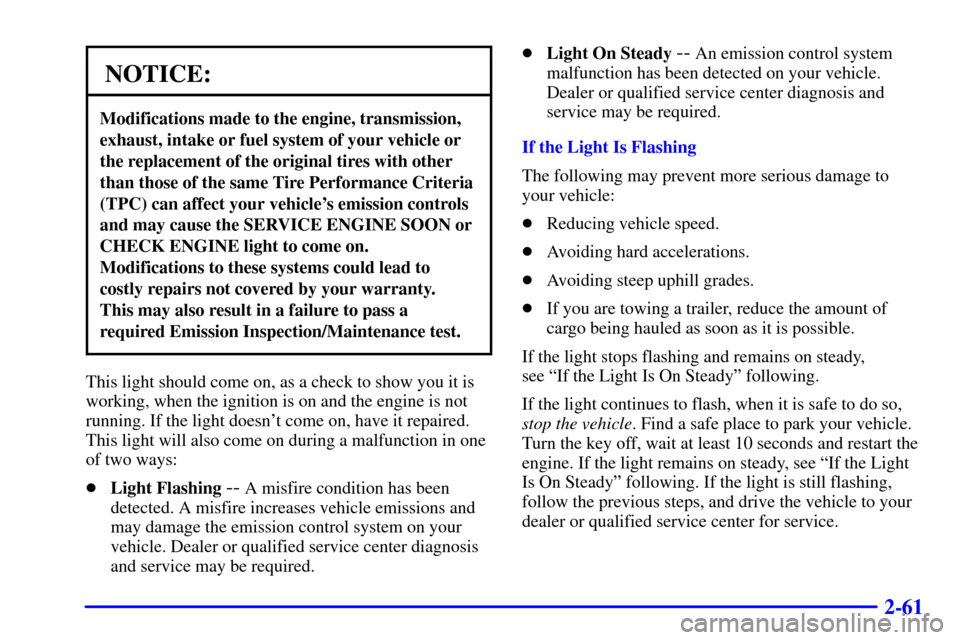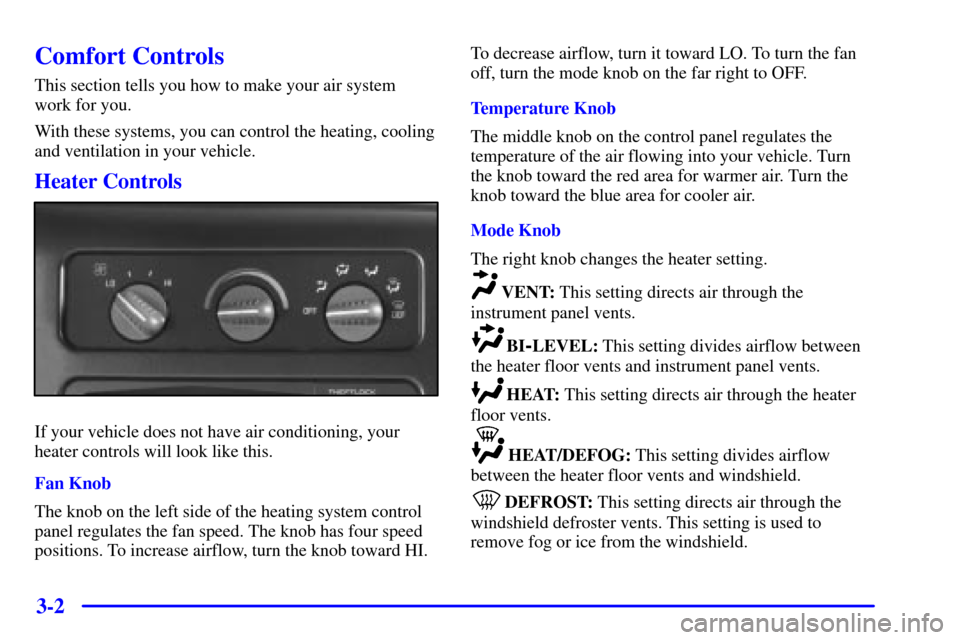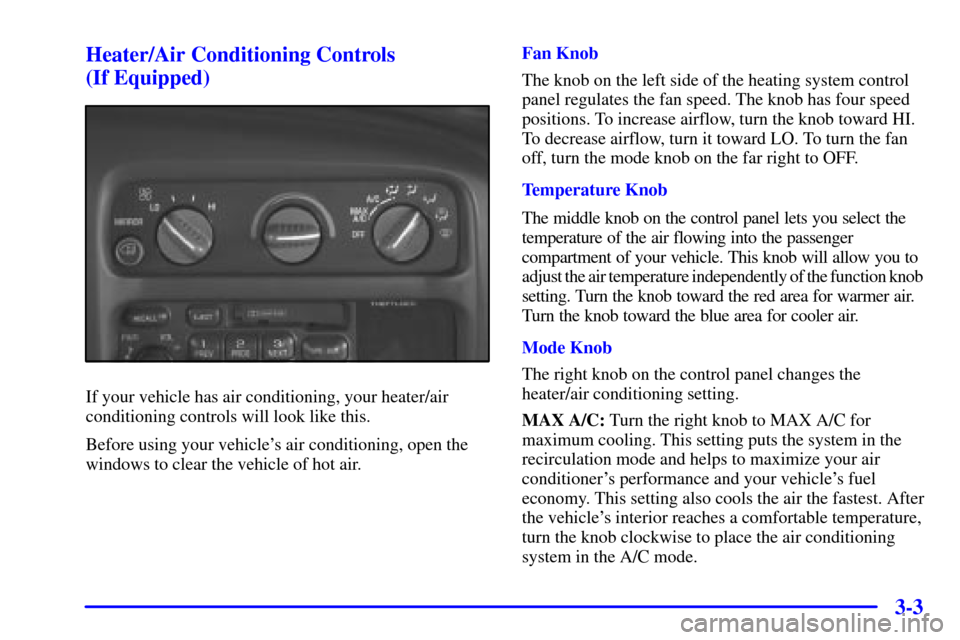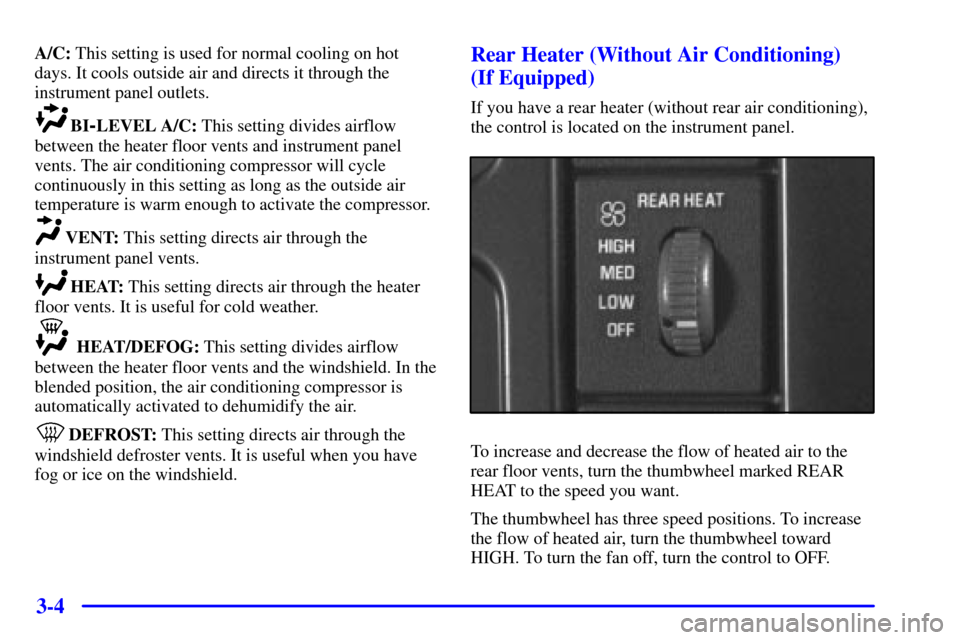Page 123 of 412
2-46 Camper-Type Mirrors (If Equipped)
If your vehicle is equipped
with the camper
-type
mirrors, they can be
adjusted so you can have a
clear view of any objects
behind you.
1. To adjust the mirrors
when towing a trailer,
turn the mirror by
pushing the mirror
head toward the front
of the vehicle.
2. Turn the mirror head
so that it swings
further outboard and
adjust the mirror
surface as needed.
Page 135 of 412
2-58
United States Canada
This light should come on briefly when you turn the
ignition key to RUN. If it doesn't come on then,
have it fixed so it will be ready to warn you if there's
a problem.If the light comes on while you are driving, pull off the
road and stop carefully. You may notice that the pedal is
harder to push. Or, the pedal may go closer to the floor.
It may take longer to stop. If the light is still on, have the
vehicle towed for service. See ªTowing Your Vehicleº in
the Index.CAUTION:
Your brake system may not be working properly
if the brake system warning light is on. Driving
with the brake system warning light on can lead
to an accident. If the light is still on after you've
pulled off the road and stopped carefully, have
the vehicle towed for service.
Page 138 of 412

2-61
NOTICE:
Modifications made to the engine, transmission,
exhaust, intake or fuel system of your vehicle or
the replacement of the original tires with other
than those of the same Tire Performance Criteria
(TPC) can affect your vehicle's emission controls
and may cause the SERVICE ENGINE SOON or
CHECK ENGINE light to come on.
Modifications to these systems could lead to
costly repairs not covered by your warranty.
This may also result in a failure to pass a
required Emission Inspection/Maintenance test.
This light should come on, as a check to show you it is
working, when the ignition is on and the engine is not
running. If the light doesn't come on, have it repaired.
This light will also come on during a malfunction in one
of two ways:
�Light Flashing
-- A misfire condition has been
detected. A misfire increases vehicle emissions and
may damage the emission control system on your
vehicle. Dealer or qualified service center diagnosis
and service may be required.�Light On Steady
-- An emission control system
malfunction has been detected on your vehicle.
Dealer or qualified service center diagnosis and
service may be required.
If the Light Is Flashing
The following may prevent more serious damage to
your vehicle:
�Reducing vehicle speed.
�Avoiding hard accelerations.
�Avoiding steep uphill grades.
�If you are towing a trailer, reduce the amount of
cargo being hauled as soon as it is possible.
If the light stops flashing and remains on steady,
see ªIf the Light Is On Steadyº following.
If the light continues to flash, when it is safe to do so,
stop the vehicle. Find a safe place to park your vehicle.
Turn the key off, wait at least 10 seconds and restart the
engine. If the light remains on steady, see ªIf the Light
Is On Steadyº following. If the light is still flashing,
follow the previous steps, and drive the vehicle to your
dealer or qualified service center for service.
Page 140 of 412

2-63
Emissions Inspection and Maintenance Programs
Some state/provincial and local governments have
or may begin programs to inspect the emission
control equipment on your vehicle. Failure to pass
this inspection could prevent you from getting a
vehicle registration.
Here are some things you need to know in order to help
your vehicle pass an inspection:
Your vehicle will not pass this inspection if the
SERVICE ENGINE SOON or CHECK ENGINE light is
on or not working properly.
Your vehicle will not pass this inspection if the
OBD (on
-board diagnostic) system determines that
critical emission control systems have not been
completely diagnosed by the system. The vehicle would
be considered not ready for inspection. This can happen
if you have recently replaced your battery or if your
battery has run down. The diagnostic system is designed
to evaluate critical emission control systems during
normal driving. This may take several days of routine
driving. If you have done this and your vehicle still does
not pass the inspection for lack of OBD system
readiness, see your dealer or qualified service center to
prepare the vehicle for inspection.
Malfunction Indicator Lamp (Service
Engine Soon Light) (Check Engine Light)
(8.1L Gasoline Engine -- Except California)
United States Canada
If this light comes on or flashes while you are driving,
two things may happen.
First, you won't notice any difference in engine
performance, but your tail pipe emissions may increase.
Second, your engine may not run properly or may stall
without warning. If either of these things happen, drive
or tow your vehicle to your dealer for service.
This light should come on when the ignition is on, but
the engine is not running, as a check to show you it is
working. If it does not come on at all, have it repaired.
Page 146 of 412

3-2
Comfort Controls
This section tells you how to make your air system
work for you.
With these systems, you can control the heating, cooling
and ventilation in your vehicle.
Heater Controls
If your vehicle does not have air conditioning, your
heater controls will look like this.
Fan Knob
The knob on the left side of the heating system control
panel regulates the fan speed. The knob has four speed
positions. To increase airflow, turn the knob toward HI.To decrease airflow, turn it toward LO. To turn the fan
off, turn the mode knob on the far right to OFF.
Temperature Knob
The middle knob on the control panel regulates the
temperature of the air flowing into your vehicle. Turn
the knob toward the red area for warmer air. Turn the
knob toward the blue area for cooler air.
Mode Knob
The right knob changes the heater setting.
VENT: This setting directs air through the
instrument panel vents.
BI-LEVEL: This setting divides airflow between
the heater floor vents and instrument panel vents.
HEAT: This setting directs air through the heater
floor vents.
HEAT/DEFOG: This setting divides airflow
between the heater floor vents and windshield.
DEFROST: This setting directs air through the
windshield defroster vents. This setting is used to
remove fog or ice from the windshield.
Page 147 of 412

3-3 Heater/Air Conditioning Controls
(If Equipped)
If your vehicle has air conditioning, your heater/air
conditioning controls will look like this.
Before using your vehicle's air conditioning, open the
windows to clear the vehicle of hot air.Fan Knob
The knob on the left side of the heating system control
panel regulates the fan speed. The knob has four speed
positions. To increase airflow, turn the knob toward HI.
To decrease airflow, turn it toward LO. To turn the fan
off, turn the mode knob on the far right to OFF.
Temperature Knob
The middle knob on the control panel lets you select the
temperature of the air flowing into the passenger
compartment of your vehicle. This knob will allow you to
adjust the air temperature independently of the function knob
setting. Turn the knob toward the red area for warmer air.
Turn the knob toward the blue area for cooler air.
Mode Knob
The right knob on the control panel changes the
heater/air conditioning setting.
MAX A/C: Turn the right knob to MAX A/C for
maximum cooling. This setting puts the system in the
recirculation mode and helps to maximize your air
conditioner's performance and your vehicle's fuel
economy. This setting also cools the air the fastest. After
the vehicle's interior reaches a comfortable temperature,
turn the knob clockwise to place the air conditioning
system in the A/C mode.
Page 148 of 412

3-4
A/C: This setting is used for normal cooling on hot
days. It cools outside air and directs it through the
instrument panel outlets.
BI-LEVEL A/C: This setting divides airflow
between the heater floor vents and instrument panel
vents. The air conditioning compressor will cycle
continuously in this setting as long as the outside air
temperature is warm enough to activate the compressor.
VENT: This setting directs air through the
instrument panel vents.
HEAT: This setting directs air through the heater
floor vents. It is useful for cold weather.
HEAT/DEFOG: This setting divides airflow
between the heater floor vents and the windshield. In the
blended position, the air conditioning compressor is
automatically activated to dehumidify the air.
DEFROST: This setting directs air through the
windshield defroster vents. It is useful when you have
fog or ice on the windshield.
Rear Heater (Without Air Conditioning)
(If Equipped)
If you have a rear heater (without rear air conditioning),
the control is located on the instrument panel.
To increase and decrease the flow of heated air to the
rear floor vents, turn the thumbwheel marked REAR
HEAT to the speed you want.
The thumbwheel has three speed positions. To increase
the flow of heated air, turn the thumbwheel toward
HIGH. To turn the fan off, turn the control to OFF.
Page 149 of 412
3-5 Rear Air Conditioning and Rear Heater
(If Equipped)
If your vehicle has a rear air conditioning and rear
heater system combination, controls are provided
to regulate the temperature, location and speed of
the airflow.
Front Passenger ControlTo adjust the air temperature, turn the temperature knob
on the right side of the control panel.
For warmer air, turn the knob toward the red area, and
for cooler air, turn the knob toward the blue area.
To regulate the airflow location, adjust the center knob
on the control panel. Turn the knob counterclockwise
for floor vent airflow or clockwise for headliner vent air
flow. Generally, the upper vents are used for air
conditioning and the floor vents for heating. The control
knob can be set to any blend setting.
To adjust the airflow speed, turn the fan knob on the left
side of the control panel to the desired fan speed.
To activate the rear control, turn the fan knob on the
front control to REAR CNTL.